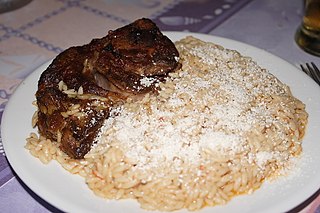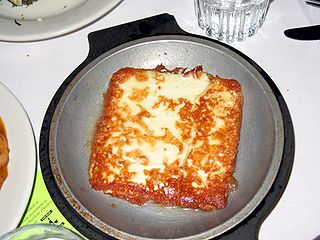Related Research Articles

Greek cuisine is the cuisine of Greece and the Greek diaspora. In common with many other cuisines of the Mediterranean, it is founded on the triad of wheat, olive oil, and wine. It uses vegetables, olive oil, grains, fish, and meat, including pork, poultry, veal and beef, lamb, rabbit, and goat. Other important ingredients include pasta, cheeses, lemon juice, herbs, olives and olive oil, and yogurt. Bread made of wheat is ubiquitous; other grains, notably barley, are also used, especially for paximathia. Common dessert ingredients include nuts, honey, fruits, sesame, and filo pastries. It continues traditions from Ancient Greek and Byzantine cuisine, while incorporating Turkish, Balkan, and Italian influences.

Turkish cuisine is the cuisine of Turkey and the Turkish diaspora. Although the cuisine took its current rich form after numerous cultural interactions throughout centuries, it should not be confused with other cuisines such as Ottoman cuisine or Seljuk cuisine. Turkish cuisine with traditional Turkic elements such as yogurt, ayran, kaymak, exerts and gains influences to and from Mediterranean, Balkan, Middle Eastern, Central Asian and Eastern European cuisines.

Halloumi or haloumi is a cheese of Cypriot origin made from a mixture of goat's and sheep's milk, and sometimes also cow's milk. Its texture is described as squeaky. It has a high melting point and so can easily be fried or grilled, a property that makes it a popular meat substitute. Rennet is used to curdle the milk in halloumi production, although no acid-producing bacteria are used in its preparation.

Meze is a selection of small dishes served as appetizers in Albanian, Bosnian, Armenian, Kurdish, Levantine, Turkish, Bulgarian, Greek, Iraqi, Egyptian, and Iranian cuisine. It is similar to Spanish tapas and Italian antipasti. A mezze may be served as a part of a multi-course meal or form a meal in itself. In non-Islamic countries, or in areas without alcohol restrictions, mezze are often served with spirits such as arak, rakia, raki, oghi or grappa.

Goat cheese, goat's cheese or chèvre is cheese made from goat's milk. Goats were among the first animals to be domesticated for producing food. Goat cheese is made around the world with a variety of recipes, giving many different styles of cheeses, from fresh and soft to aged and hard.

Kasseri is a medium-hard or hard pale yellow cheese made from pasteurised or unpasteurised sheep milk and at most 20% goat's milk. "Kasseri" is a protected designation of origin, according to which the cheese must be made in the Greek provinces of Thessaly, Macedonia, Lesbos, or Xanthi, but a similar type of cheese is found in Turkey, Romania, and the Balkans, where it is known as kashkaval. The same cheese is made with cow's milk, but in that case it cannot be legally sold as "kasseri" in the EU and is instead sold under names that are particular to each producer.

In Greek cuisine, saganaki is any one of a variety of dishes prepared in a small frying pan, the best-known being an appetizer of fried cheese. It is commonly flambéed in North America.

Börek or burek is a family of pastries or pies found in the Balkans, Middle East and Central Asia. The pastry is made of a thin flaky dough such as filo with a variety of fillings, such as meat, cheese, spinach, or potatoes. Boreks are mainly associated with the Middle East, Caucasus, and also with the former Ottoman Empire, including the Balkans and the South Caucasus, Eastern European and Central European countries, Northern Africa and Central Asia. A borek may be prepared in a large pan and cut into portions after baking, or as individual pastries. They are usually baked but some varieties can be fried. Borek is sometimes sprinkled with sesame or nigella seeds, and it can be served hot or cold.
White cheese includes a wide variety of cheese types discovered in different regions, sharing the sole common characteristic of their white hue. The specific type of white cheese can vary significantly depending on the geographical location.
Teleme or teleme peyniri is a white semi-soft cheese made from cow's, goat's, and sheep's milk, originating in ancient times in the Middle East and Mediterranean.
The cuisine of Kosovo is a representative of the cuisine of the Balkans and consists of traditional dishes by ethnic groups native to Kosovo. Due to ethnic connections with Albania, it has been significantly influenced by Albanian cuisine and has adopted elements of other Balkan countries.

Many cuisines feature eggplant salads and appetizers.

Baklava is a layered dessert made of filo pastry sheets, filled with chopped nuts, and sweetened with syrup or honey.

Kopanisti is a salty, spicy cheese, with protected designation of origin (PDO) produced in the Greek islands of the Cyclades in the Aegean Sea such as Mykonos, Tinos, Andros, Syros, Naxos etc.; it has been produced in Mykonos for more than 300 years. It owes its special peppery and spicy taste to rapid and extensive lipolysis and proteolysis caused by abundant microbial growth encouraged by repeated kneadings performed during the ripening process.

The traditional cuisine of Abruzzo is eclectic, drawing on pastoral, mountain, and coastal cuisine. Staples of Abruzzo cuisine include bread, pasta, meat, fish, cheese, and wine. The isolation which has characterized the region for centuries has ensured the independence of its culinary tradition from those of nearby regions. Local cuisine was widely appreciated in a 2013 survey among foreign tourists.

Pogača is a type of bread baked in the ashes of the fireplace, and later in modern ovens. Found in the cuisines of the Balkans, Levant, and Hungary it can be leavened or unleavened, though the latter is considered more challenging to make. It is generally made from wheat flour, but barley and sometimes rye may be added. It can be stuffed with potatoes, ground beef, olive, or cheese, and have grains and herbs like sesame, black nigella seed, or dried dill in the dough or sprinkled on top.
Tomas Peyniri or Karın kaymağı is the name of a Turkish cheese traditionally made of sheep's milk and goat milk. Tomas cheese which is among the cheeses produced in Tulum in Eastern Anatolia Region took its name from the word of tomas which means in Greek as leather.

Künefe peyniri a Turkish cheese made of cow milk, goat milk, or a combination, and used to prepare künefe.
Civil peyniri is a brined string cheese that originated in Turkey. Civil cheese is one of the most important traditional foods, which produced and consumed especially in Kars and Erzurum. Civil peyniri a Turkish cheese made of sheep's milk, cow milk, goat milk, or a combination.
Cheese dessert of Biga is a Turkish dessert dish. It originates from the district of Biga, Çanakkale Province in Turkey.
References
- ↑ YAŞİN, Mehmet. "Peynir bizim işimiz". www.hurriyet.com.tr (in Turkish). Retrieved 2021-04-25.
- ↑ "Anadolu'da peynir peşinde bir yolculuk | Aynur TATTERSALL | Köşe Yazıları". 2021-01-14. Archived from the original on 2021-01-14. Retrieved 2022-05-19.
- ↑ "50 peynirli şehrin yöresel mandırası". 2021-04-25. Archived from the original on 25 April 2021. Retrieved 2022-05-19.